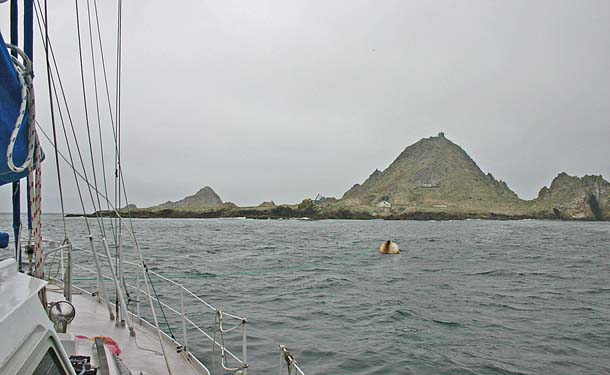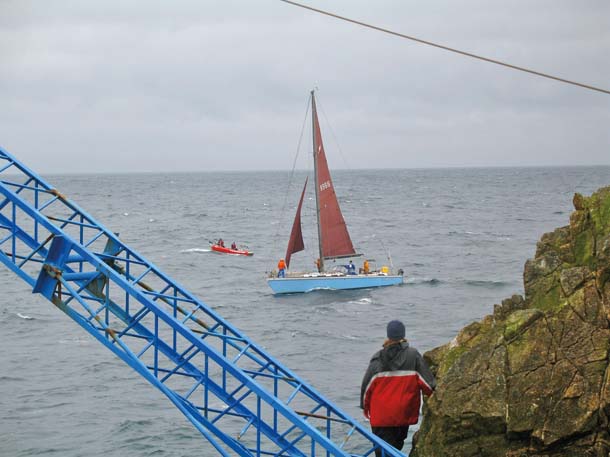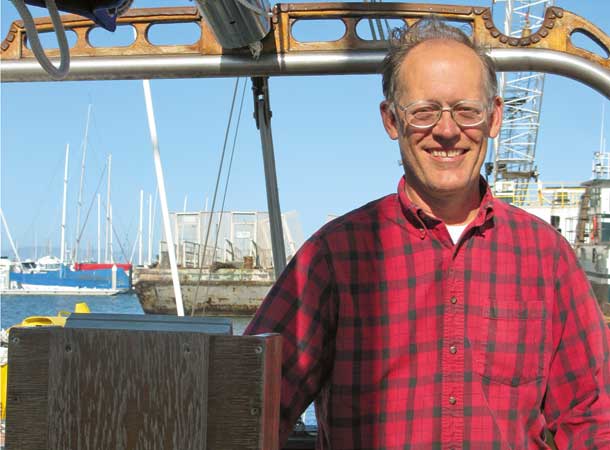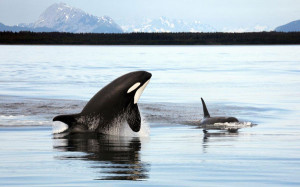John Wade is one of about 20 skippers who make up the Farallon Patrol for PRBO Conservation Science. Skippers offer their boats and volunteer their time to sail to the Farallon Islands, a shuttle and resupply the scientists who live and work on Southeast Farallon Island, a critical seabird and marine mammal breeding site. The shuttle makes the run to the island — located 30 miles west of the Golden Gate — every two weeks or so. We caught up with Wade recently on his 40-foot sailboat, the Starbuck, at dock in the San Francisco Marina.
DM: How did you get involved with the Farallon Patrol?
JW: In 1984 the owner of this boat was Ralph Nobles, a Midwest farm boy turned physicist and environmentalist; a very bright guy. Anyway, we were involved in the fight with Mobil Oil over the development of Bair Island in Redwood City. So we got to be friends, and he invited me to crew for him on one of his trips out to the Farallones. We did about two a year up until about 1995, when he sold me the boat. Now I do four or five trips a year.
DM: And what are you shuttling to the Farralon Islands?
JW: On a typical run we’ve got 600 to 1,000 pounds of food and supplies: propane, gas cans — whatever they need to keep everything in stock for the next two weeks or more. And typically we’ll have two or three biologists going out to the island and two or three coming back and maybe two or three other volunteers from PRBO who ride out and back. On the way back we bring all of the recycling, all of the compost, you name it. One time we brought back 40 boxes of scientific journals that they had out there on the island that were starting to decay; they’ve got most of that data online now.

DM: Is there such a thing as a routine trip to the Farallones?
JW: On about 50 percent of the trips, we motor out in calm conditions in the fog with kind of a long, gentle swell. And then about five, 10 miles from the island the fog clears off and you’ve got a nice wind for the next 10 miles. Then we tie up at the buoy offshore there, and then they come out with a shore boat. Usually it’s kind of a very pleasant, easy, broad-reaching downwind run back to the Golden Gate and just a lovely, lovely ride.
The other 50 percent are much more varied: We’ve never been out in really stormy conditions. Maybe two or three trips were mildly stormy. But if the seas get over about eight or 10 feet the landings wash out and even though my boat will get out there you can’t get the supplies and people ashore, so there’s no point.
DM: Have you ever had to abort a trip?
JW: There was one run where we were barely able to get everything off the boat and out of there; it was dicey enough where they just wanted to do one run in with the shore boat, so we just dumped all the food in their boat and they took off and we took off.
And there was one run where we were OK on the boat, but the landing conditions deteriorated in the course of an hour, so we ended up hauling two five gallon jugs of oil and six bags of concrete back to the mainland with us.
But those were the only two runs out of about 70 that we weren’t able to complete once we got under way.
Once in a while, you get this little run from heaven. The nicest run was on December 5, a very warm sunny day, east wind blowing out the Gate, and we ran dead downwind all the way to the island in this balmy 70-degree weather — in December! While we are unloading the wind backs from the east to the north so then we sail all the way back on a beam reach in the same beautiful warm sunny weather. It’s sort of like . . . it’s as close to heaven as you can get.
Then there was one run that was kind of interesting. We went out right at the edge of a mild storm front and as we headed out the wind [swung] back around from northwest down to the south. And about five to 10 miles from the island, it started raining, but the wind stayed pretty steady, so we just kept going. And when we got to the island — in the rain you don’t wait around for much, it’s pretty much “get it in the boat and let’s go.” And that was winter, so sunset was five o’clock. By the time we got done it was close to sunset, and we cast off and started heading back. By that time the wind had started picking up more from the south — probably another couple of hours and we couldn’t even have landed. And then we just headed back in, and the wind picked up and picked up and we were kind of hunting through the rain to find the channel markers and then, just before I was about to heave-to for a little nav check, one of the guys — that’s a great thing about biologists, they’re very sharp observers — sees the buoys and great, we’re right on course.
Then right as we come in to Point Bonita the wind does a snap 180 degree shift from south to north and the boat does a full standing jibe, just bang, bang, and the boom flies over to the other side, the rain stops, and the sky just kind of opens up and there’s these big white puffy clouds and it’s a full moon coming up over Berkeley, so all of these clouds are backlit — they have this glowing white fringe around them — and it’s like you’ve gone through purgatory and now you’ve arrived in heaven. Here’s the Golden Gate Bridge with all its lights on and all of these big, puffy white clouds and a big full moon, and the wind is 15 knots from the north and we just have that last hour to go and it’s just heavenly. That was a good trip.

DM: What about interesting wildlife sightings?
JW: Some of the fun things: About five miles before the island, usually in the summer, there’s a pod of humpbacks that are out there, kind of sporting around. They’re not somebody you want to get too close to because they’re very frisky and they’re very big, but they’re nice to watch from a couple of hundred yards away. There’s a resident gray whale that’s there much of the year, just swimming circles around the island and feeding in the local area.
Then there was one run where I got to go ashore and we went up the hill to the lighthouse, and the guy on shark watch there said they had a hit about a mile south of the island and you could see this big pink stain in the water and a fin going around and thrashing going on, and then the animal bled out and the shark just went ahead and fed. The biologist went out very fast to film it and to monitor what was going on — the feeding behaviors — but we had to go back to our boat.
DM: Have you sailed much in other places?
JW: I’ve been sailing up the Delta and inside the Bay since I was 12. And then in the Sea Scouts, we went down to Southern California. I’ve taken this boat down to Southern California, but I haven’t really structured my life in a way where I can take off for three or four weeks straight.
DM: So how does the stretch of water out to the Farallones compare to the Bay and Delta?
JW: It’s quite different. You can get the same amount of wind that you get inside the Bay, but out there you get significantly larger waves. And that’s really the main difference — the size of the waves.
DM: What do you do when you are not sailing?
JW: I’ve been working on protecting and maintaining the San Mateo coast my entire adult life, since ’74, and I expect I will be for a while to come. I worked for Peninsula Open Space Trust for 19 years, doing land acquisition — sort of doing land management and acquisition at the wholesale level. When I left there I went to work managing one or two specific pieces of land — a private estate down on the coast near Año Nuevo, and then I also manage Cascade Ranch historic farm, which is a fixer-upper project at this point, but eventually we’re going to make it into an organic farming community.
DM: And any plans for more sailing in your future?
JW: I’d love to someday take off and do some long distance sailing. Maybe I’ll get a chance to do that, and maybe not. In the meantime the way I can guarantee to get some ocean time in and meet interesting people is to do the runs for PRBO. Once I get them on my calendar they’re like sacred dates; nothing can get in their way.





